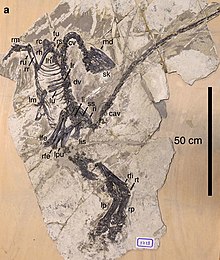| Jianianhualong Temporal range: Aptian,
| |
|---|---|

| |
| Type specimen of J. tengi | |
| Scientific classification | |
| Domain: | Eukaryota |
| Kingdom: | Animalia |
| Phylum: | Chordata |
| Clade: | Dinosauria |
| Clade: | Saurischia |
| Clade: | Theropoda |
| Family: | †Troodontidae |
| Genus: | †Jianianhualong Xu et al., 2017 |
| Type species | |
| Jianianhualong tengi Xu et al., 2017
| |
Jianianhualong (meaning "Jianianhua dragon") is a genus of troodontid theropod dinosaur from the Early Cretaceous of China. It contains a single species, Jianianhualong tengi, named in 2017 by Xu Xing and colleagues based on an articulated skeleton preserving feathers. The feathers at the middle of the tail of Jianianhualong are asymmetric, being the first record of asymmetrical feathers among the troodontids. Despite aerodynamic differences from the flight feathers of modern birds, the feathers in the tail vane of Jianianhualong could have functioned in drag reduction whilst the animal was moving. The discovery of Jianianhualong supports the notion that asymmetrical feathers appeared early in the evolutionary history of the Paraves.
Jianianhualong possesses a combination of traits seen in basal as well as traits seen in derived troodontids. This is consistent with its phylogenetically intermediate position among the troodontids. This mixture of traits shows a distinct spatial organization, with basal traits being present in the forelimbs and pelvis, and derived traits being present in the skull and hindlimbs. This may represent a case of mosaic evolution, where natural selection acts upon the form of the body in a modular way. Similar transitional patterns of traits are seen in the troodontid Sinusonasus, a close relative of Jianianhualong. Ecologically speaking, Jianianhualong and Sinusonasus are part of the considerable diversity of troodontids that is present within the Yixian Formation.